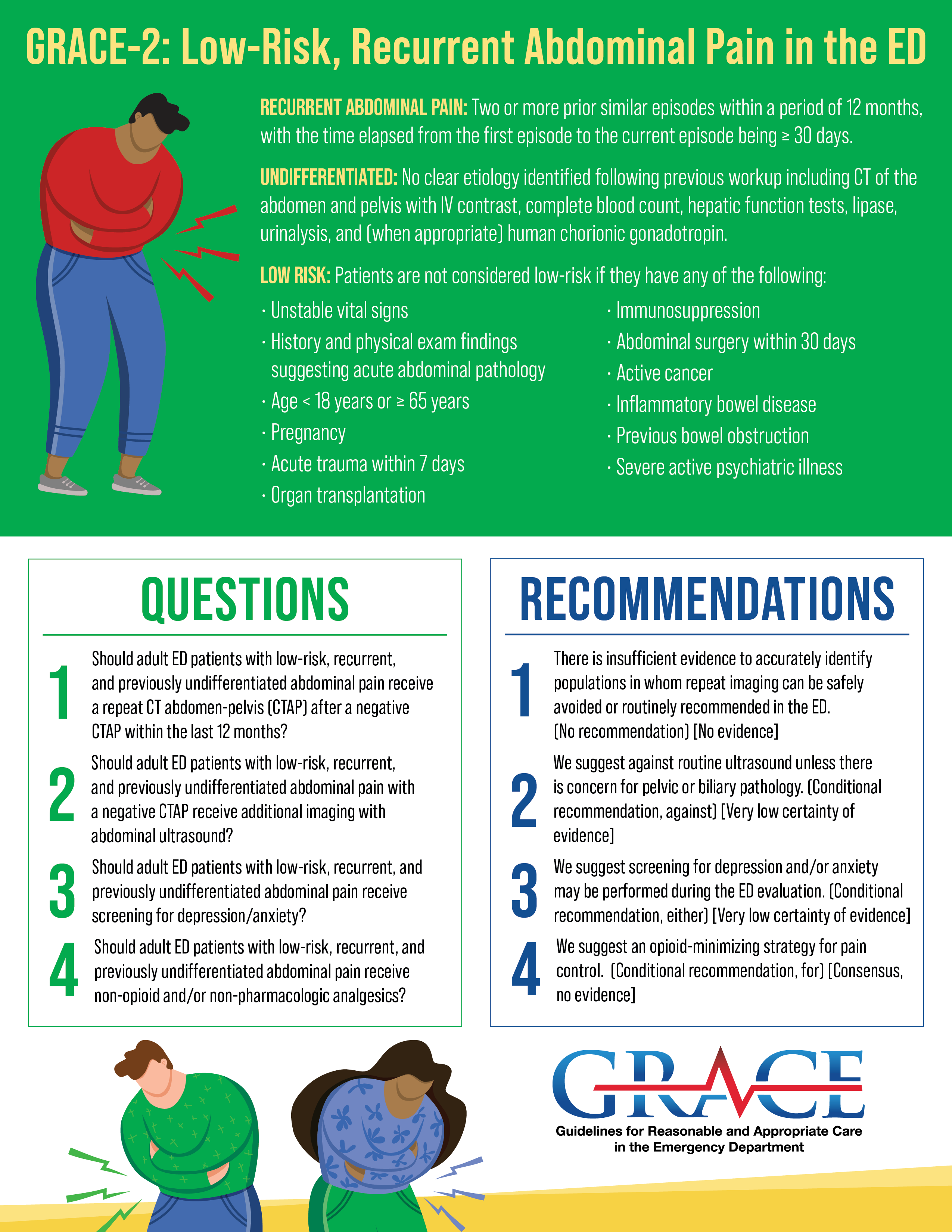GRACE-2

The SAEM GRACE program addresses the best practices for the care of the most common chief complaints that can be seen on the tracking board of any emergency department in the country, based upon research and expert consensus. These guidelines are designed with de-implementation as a guiding principle to reasonably reduce wasteful testing, provide explicit criteria to reduce foreseeable risk, and define sensible and prudent medical care.
GRACE-2: Low-Risk, Recurrent Abdominal Pain in the Emergency Department
Abdominal pain has consistently remained the most frequent chief complaint in United States emergency departments (EDs) from 2009 to 2018. The evaluation of acute abdominal pain requires substantial ED resources, including imaging, laboratory studies, nursing care, time, and patient care space. Despite the intensity of diagnostic testing, most patients presenting with abdominal pain do not receive a specific diagnosis in the ED and are discharged.
National data on ED presentations for recurrent abdominal pain are limited. Little guidance is available to emergency physicians evaluating and treating patients with recurrent and undifferentiated abdominal pain. Without guidelines for care, variance in practice could result in lower quality care, including risks of over- or under-testing, misdiagnosis, adverse effects of over- or under-treatment, higher costs, greater length of stay, and lower patient satisfaction.
The purpose of the second Guideline for Reasonable and Appropriate Care in the Emergency Department (GRACE-2) is to provide an evidence-based, patient-centric approach for clinicians in their evaluation and management of adult patients with low-risk, recurrent, undifferentiated abdominal pain in the ED.
The GRACE-2 panel reached the following recommendations:
- If a prior negative computed tomography of the abdomen and pelvis (CTAP) has been performed within 12 months, there is insufficient evidence to accurately identify populations in whom repeat CTAP imaging can be safely avoided or routinely recommended.
- If CTAP with IV contrast is negative, the panel suggests against ultrasound unless there is concern for pelvic or biliary pathology.
- The panel suggests screening for depression and/or anxiety may be performed during the ED evaluation.
- The panel suggests using an opioid-minimizing strategy for pain control.
Read the full article:
GRACE-2: Low-Risk, Recurrent Abdominal Pain in the Emergency Department
Podcast:
GRACE-2 Podcast on The Skeptics Guide to Emergency Medicine

Guideline Infographics
Patient Information Handout
Related Articles
- Repeated computed tomography in recurrent abdominal pain: An evidence synthesis for guidelines for reasonable and appropriate care in the emergency department
- Depression and anxiety screening in emergency department patients with recurrent abdominal pain: An evidence synthesis for a clinical practice guideline
- A Candle in the Dark: The Role of Indirect Evidence in Emergency Medicine Clinical Practice Guidelines
Press Release
Other GRACE Guidelines
GRACE-1: Recurrent, Low-Risk Chest Pain in the ED
GRACE-3: Acute Dizziness in the ED
GRACE-4: Alcohol Use Disorder and Cannabis Hyperemesis Management in the Emergency Department
GRACE-5: Syncope (2025)
